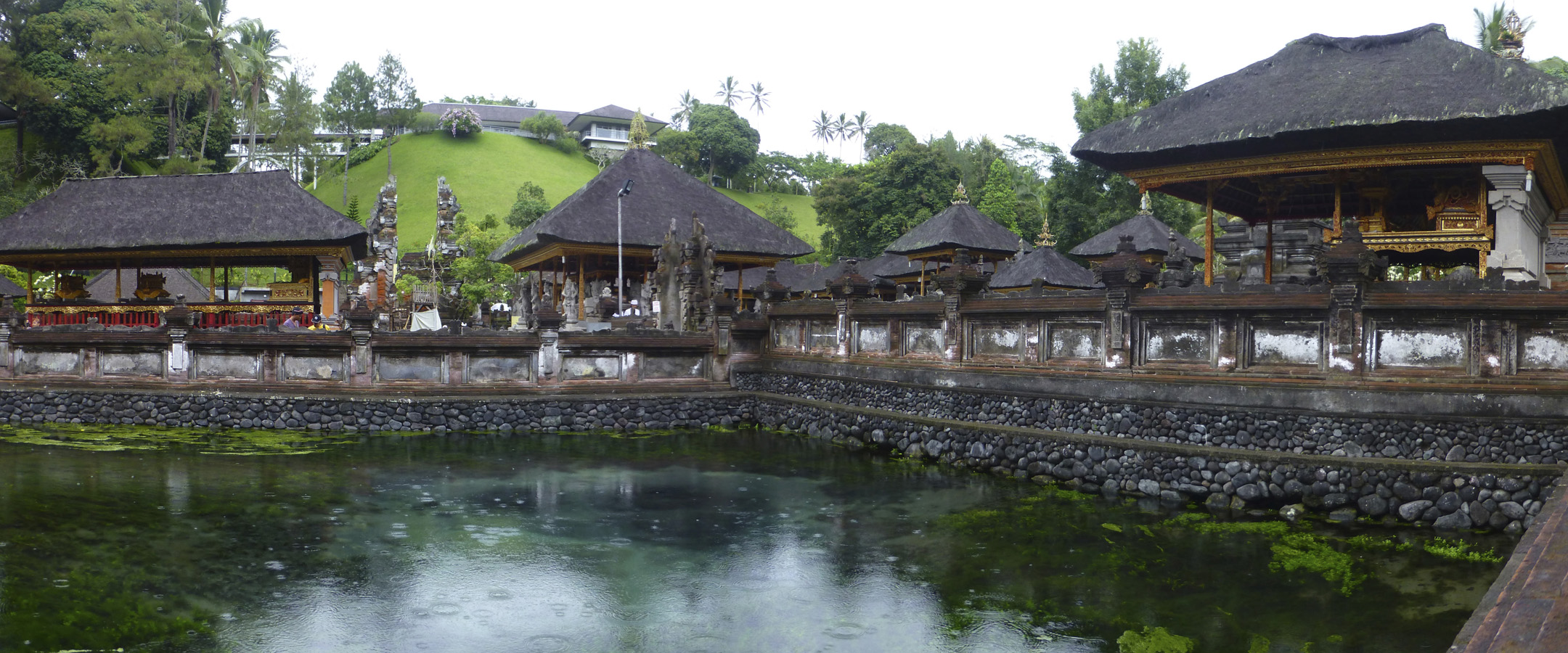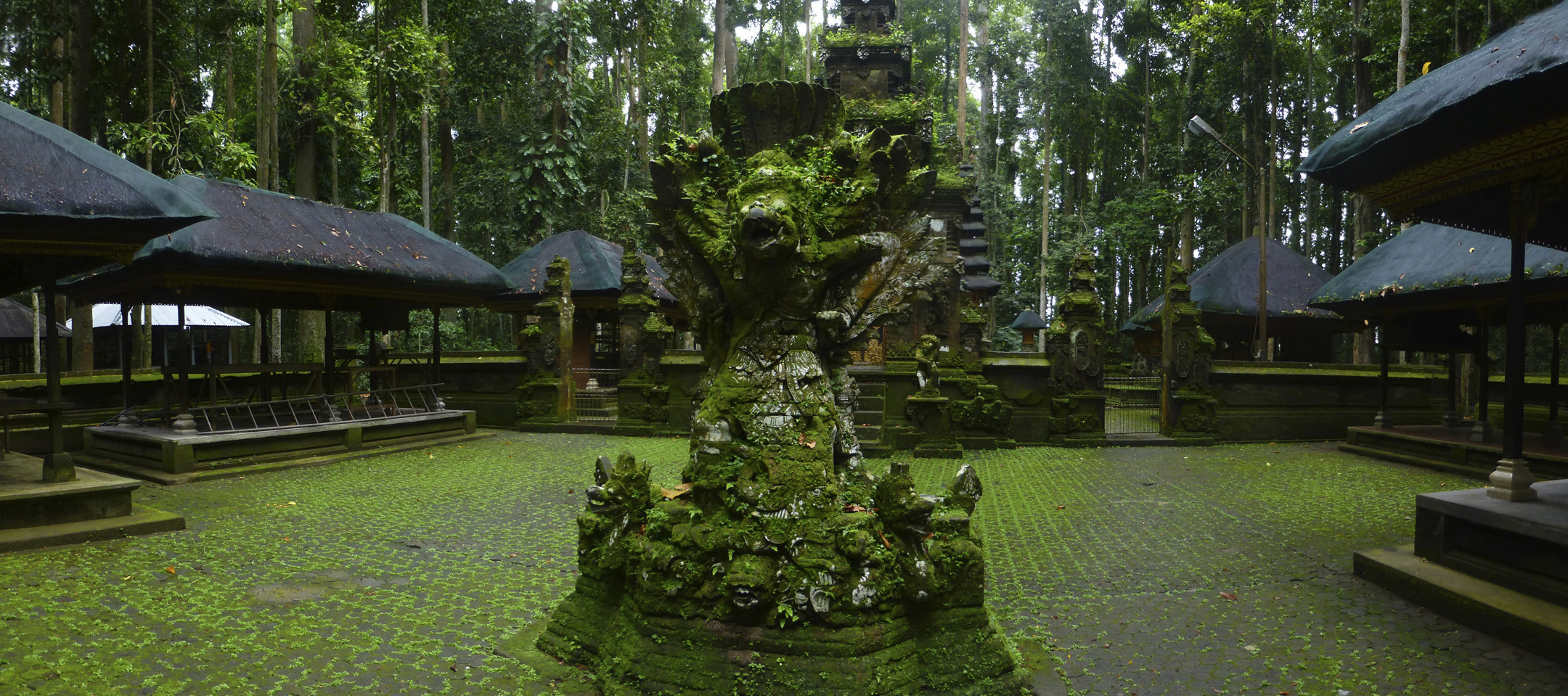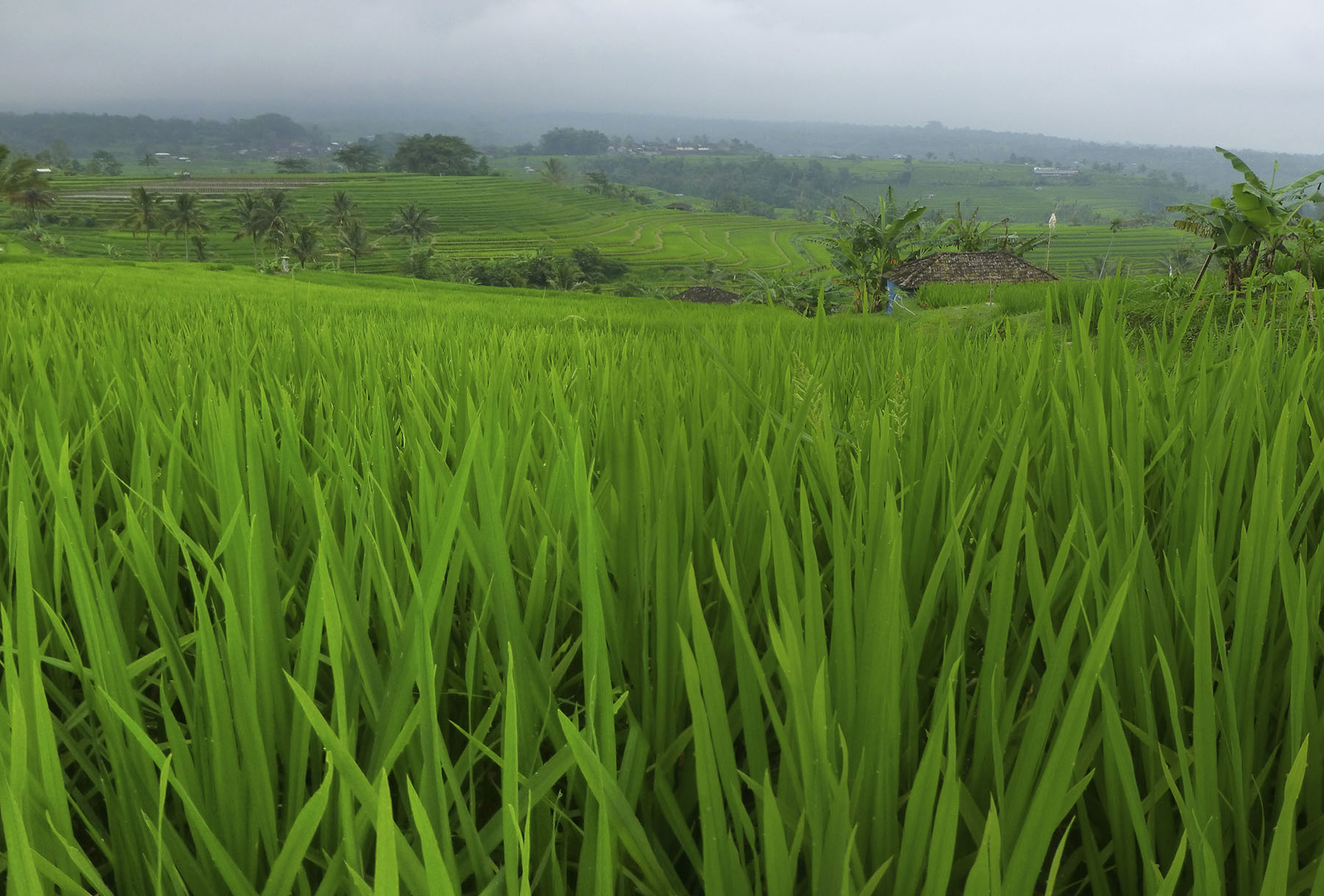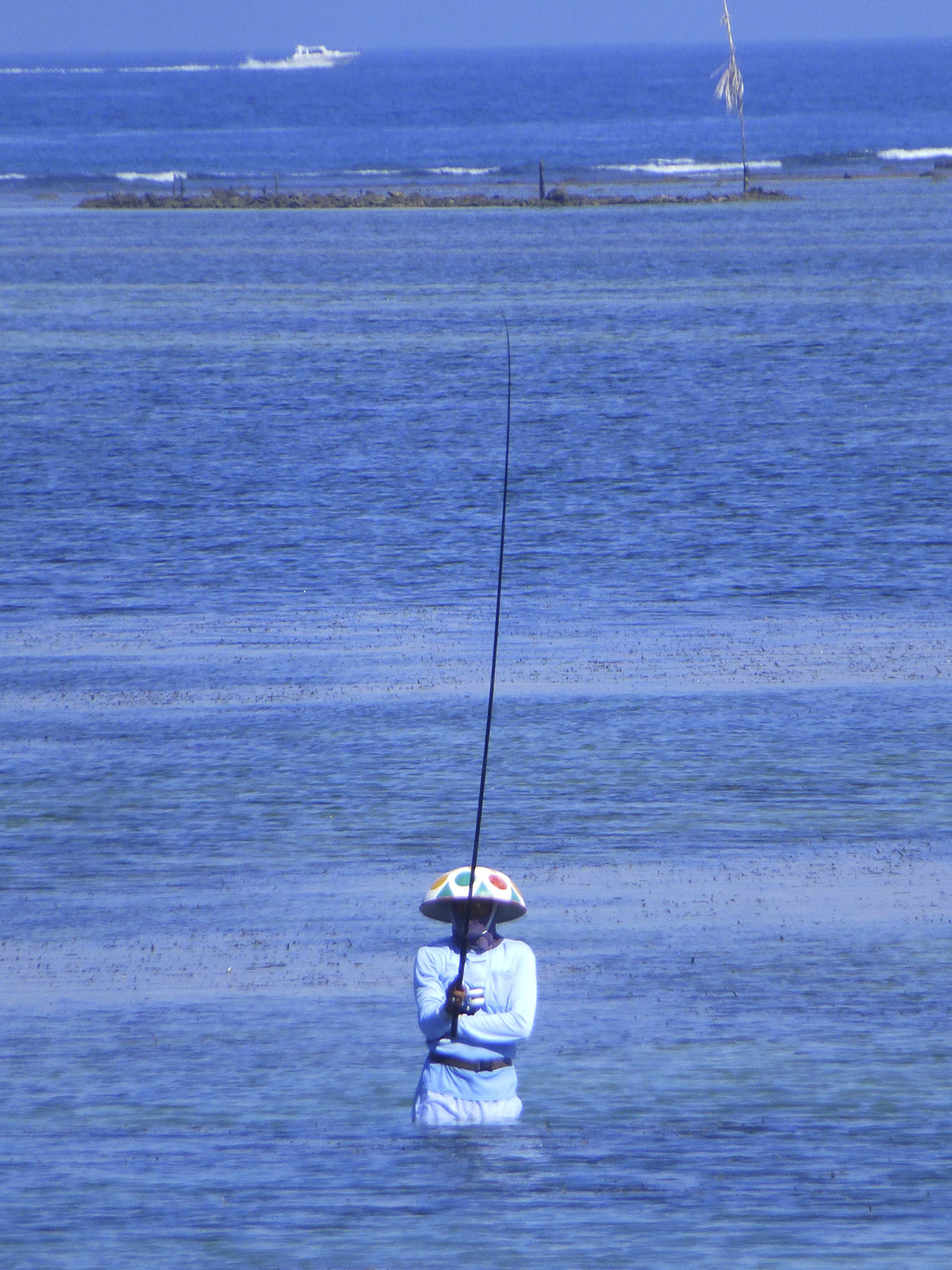3/13/14 – 3/19/14: Bali, Indonesia
After spending roughly four months in western worlds, traveling through Australia and New Zealand, we were suddenly thrust into much-needed culture shock when we landed in Bali, Indonesia.
The night was black and the air was thick as we stepped off the plane in Denpasar. Luckily, an old high school friend, Chris, was there to greet us. Being an American expatriate living in Indonesia, he and his family were vacationing in Bali and they decided to meet up with us for some tourist fun. He’d prearranged housing and a driver to take us around the island. Made (pronounced Mah-day) was a nice local man who shook our hands and took our bags before opening the door to his roomy SUV and slipping behind the wheel. Made was under the weather, Chris explained, but was still up for being our driver around his native land. In retrospect, this would’ve been a good moment to put hand sanitizer on, but when you’re being whisked into a darkened jungle at night with no idea where you’re going you tend to forget these things.
We knew we were heading toward our local lodging in a village outside of Ubud, but we couldn’t have pinpointed our destination on a map to save our lives. The pitch-blackness that filled our windows as we sped down the road lent no further confidence about our surroundings. Chris explained that he and his family were staying at a homestay run by a man named Wayan and his wife, Ayu. We’d be staying at Wayan’s cousin’s villa down the road, but we’d be eating breakfast at Wayan’s every morning with Chris and his family.
After two hours rushing through a moonless night we arrived at Wayan’s cousin’s homestay and were shown our private bungalow. Wayan explained that these homestays are part of a larger design to increase sustainable tourism for his people so they can maintain their way of life. Our lodging in his remote village, away from the hustle and bustle of Ubud, was incredibly helpful to his community. I was fascinated by the conversation and would’ve talked much longer but, having traveled from New Zealand where the current time was 4AM, I could barely keep my eyes open. So we said our good nights before falling into a deep, albeit sticky sleep. I say sticky because the villa was open air with no air conditioning and Bali has 100% humidity with high temperatures, even at night so…. Yeah, we were sticky.
I awoke in the night by a tiny construction worker sawing on the ceiling. At least, I would’ve thought as much had Chris not warned us about the gecko’s call. These medium sized lizards like to crawl indoors and make a ruckus in the middle of the night. Chris’ warning was greatly appreciated since the gecko’s stuttered bellow would’ve otherwise had me swinging my flashlight in a frenzied panic. Instead I acknowledged his presence in a sleepy haze, grateful for the mosquito net hanging around the bed.
The scent of burning peat invaded my nostrils, hungry hens clucked excitedly nearby, and my eyes drifted open as morning sunlight filtered into our room. Our trip to Bali had yet to yield any sights or sounds, save for our gecko friend. Now, with some sleep under our belts, the light of day granted us our first real view of this foreign land. Our bungalow was built out of supple wood, intricately carved in Balinese design with gold leaf adding to its beauty. A single door led to a private bathroom and outdoor shower where jungle vegetation grew at your feet and dripped from above. Our patio faced a newly planted garden where rising heat caused mist to form before our eyes and blur our surroundings like a photo filter. An elderly Balinese woman emerged from the fog, sweeping the stone walkway with a palm frond. She was humming to herself, working completely topless and without modesty. Yes, we’d been transported overnight into another world filled with new sights, sounds, and culture. It was a world of intensity and magic and we were excited to make its acquaintance.
Katie and I had become lazy travelers while touring Australasia, always knowing food was safe to eat and modern amenities were just around the corner. Not to say Bali isn’t tourist friendly. It’s a tourist haven and is essentially Australia’s version of Hawaii. But Katie and I hadn’t fully prepared ourselves for this change of scenery and we were finding ourselves at a loss that first morning, not truly knowing where we were or what we’d be doing over the next few days. But we knew we’d be meeting up with Chris and family soon and start to settle into our new surroundings.
When we stepped outside to face the day two young men offered to drive us over to Wayan’s homestead for breakfast. They were both in their early teens, but we didn’t hesitate. They were obviously used to confused tourists waking up in the jungle searching for a meal. Lead the way, boys!
We straddled the back of their motors (pronounced moe-tohrs) and sped down the narrow road. Motors range from scooters to mopeds to motorcycles and everything in between. They are prolific in South East Asia since they’re the fastest way to get from point A to point B when roads are filled with cars, carts, animals, pedestrians, and other motors. In this quiet jungle village, however, we had no traffic to contend with as our chauffeurs drove us to Wayan’s home. We zipped along narrow roads with tropical forest rising up on both sides. Speeding along, we saw villagers tending to their morning routines and issuing daily offerings at small home-side temples. Vagabond dogs gave chase at our heals and moist heat blew threw our hair like a blow dryer. Within ten minutes we were at Wayan’s home where we met his wife Ayu who put together a delicious breakfast of banana pancakes and fresh tropical fruit. We also met Chris’ family: his wife, Carla, his mother, Kathy, and his two adorable children Tiama (2) and baby Athea.
Our first day traveling around Bali together was very eventful. It started with lunch where I accidentally ate a very hot sauce followed by eating an extremely hot pickled pepper I thought was a green bean. I was being such a Bule! (pronounced “bu-lay”). Bule is an Indonesian term for a white foreigner, like myself. It’s possibly an offensive term, though I took no offense. I was already red in the face and choking, so there was little room for further embarrassment.
To beat the heat, we traveled down the road to a water temple called Tirta Empul, which was founded at a large freshwater spring back in 962 A.D. Before entering the temple, all men and women are given sarongs to wear. I wasn’t sure of the exact meaning behind this, but I know it was tied to our purity. Children don’t need a sarong to enter the temple because Hindus believe in reincarnation, and in Balinese culture children are old souls come back to earth. In this way, children are born pure and are venerated in their society. For example, when we arrived at the restaurant earlier in the day the waitress quickly asked to hold Athea, but it wasn’t for a quick cuddle. For nearly the entire meal she carried Athea all around the restaurant as she worked, including into the kitchen. She was essentially babysitting her while we ate! This cultural love for infants was on display every time we entered a restaurant. Athea was a like a little rock star! (As she should be, she’s positively adorable.)
When we entered the water temple we saw many people bathing in communal pools, standing under waterspouts and bowing their heads in prayer. The water is a tangible blessing to cover oneself in and purify the spirit. In that heavy heat it looked very inviting, and perhaps I would’ve been tempted if I hadn’t felt it would be sacrilegious for me to participate. At that point in time my knowledge of Hinduism was limited to a single episode of Xena: Warrior Princess, so no, I didn’t feel comfortable partaking in a sacred act with that pathetic amount of understanding!
Within an encroaching jungle, the temple had the facade of a newly discovered ruin. Moss crept along the lines of intricate sculptures depicting Gods with human and animal properties melded together. Their bodies were wrapped in sarongs of their own, the cloth dripping in moisture. The inter sanctum of the temple was closed off to the public, but I could peer inside and see devotees praying and laying offerings at the feet of monkey-headed deities. I could’ve stayed for hours gazing at the sculptures and the twisted jungle vines, but rain started drizzling. Though it was a welcome coolant, drizzle can turn into downpour quickly, so we headed back to our villas.
Bath-time voyeurism turned into action once we returned home. I luxuriated in a cold shower and thanked the Hindu gods, myself. You quickly learn in South East Asia to take advantage of cold showers whenever the opportunity arises. Otherwise you become stuck to yourself, which no one wants to see, let alone experience.
That evening we took in our first “dance.” There are many cultural performances you can experience in Bali, most are called “dances” and may include dance but can also incorporate acting, singing, chanting, and even fire-wielding dramatics. Our first dance was the Kecak Fire & Trance Dance. No band performed but there was music of a type. One hundred men formed concentric circles, their bodies swaying in unison as they chanted a beat: “Chack, chack, chack, chack, chack, chack, chack…”
Actors in elaborate costumes entered the space and performed a tale from the Ramayana Epic. Flames lit the stage while the actors pranced around and the “chack, chack, chack” chant undulated to the pace of the fable. I can’t say I could follow what was happening, but the experience was unique and hypnotic. The performance was capped off with an elderly man coming on stage for the “trance dance.” While riding a grass-woven horse, he walked, kicked, and stomped through burning coals. It was extremely impressive!
On our second day Chris and Tiama joined us at the Monkey Forest Sanctuary where hundreds of grey macaques were anxiously waiting to meet us. Well, not us exactly, but the peanuts we were going to give them. They love meeting those peanuts! When I think of monkeys I think of small adorable mammals with cute faces and long tails. Grey macaque babies fit that description, but their parents? Not so much. They are BIG! That’s why each visitor is assigned a guide to walk you around the sanctuary and keep you safe. These guides are well aware of the nature of macaques and the foolish tourists who want to interact with them. With this knowledge they’ve designed the ultimate way to make everyone’s dreams come true: Place a peanut in the tourist’s hand and tell them to hold still. Sure enough, a grey macaque the size of a large raccoon (and with roughly the same amount of manners) jumps on your back, head, and shoulders before snatching the peanut and leaping off you like you’re a dead tree stump. I felt a true connection with the animal in that moment. The same type of connection a dog dish feels with its owner.
An intimidating statue of a Kumbhakarna, a giant Hindu god in the form of a monkey, stood at the entrance to the Pala Forest. With his face snarling, his monstrous form wrestled stone monkeys while real macaques jumped from his head, to his arm, to his shoulder, as if trying to escape his grasp. Our guide led us past this surreal image and into the lush forest beyond. Ancient temples rose up under the green canopy, every inch dripping with vegetation. Moss tinted the sacred structures like patina on bronze. The temples were closed to visitors and were only opened for sacred rituals. That is, except for the monkeys – they often use them to take refuge from the rain. But our guide told us they are revered in their culture, so I think the worshippers approve.
Grey macaques are territorial and stick with their clan, so as we moved from one area of the sanctuary to another a new family would emerge from the trees, lurking on the fringes of our path. At one point, while Chris was holding Tiama and buying extra peanuts, an overzealous macaque jumped up on both of them and nabbed the nuts! This frightened Tiama considerably (understandably so) and it took her a while to calm down. I hope she still likes monkeys after that experience. As for me, one macaque feeding will last me a lifetime.
The next morning we attended our second “dance” called a Barong and Kris dance. A more theatrical production took place on stage, telling another tale from the Ramayana. They didn’t need much by way of sets because the drama unfolded within a temple. The setting alone was worth the price of admission. Off to the right was a small band performing on percussive instruments. They sounded like an instrumental representation of the repetitive chanting the men sang during the Kacek dance. This type of music is called gamelan and it’s traditional in Indonesian culture. The repetitiveness gives it a meditative quality, the rising and falling rhythm setting pace as the story unfolds. The costumes were intricate, with added flourishes and vibrant colors that enunciated actors’ movements when they danced or gestured. Well, there was one exception to this. For whatever reason, the costume for Hanuman, the monkey god, looked like a kid’s pajamas. No idea why. Maybe the real costume was stuck at the dry cleaners?
Immediately after the show we drove south to Seminyak, a popular beach resort area for tourists. Under the beating heat we searched for a restaurant Chris recommended. When we couldn’t find it right away we stopped for a cold drink in a café to relax for a spell while Chris and Tiama played in the shallow waves. This was Tiama’s first time visiting the ocean, and this was my first time visiting a Bali tourist zone. There were motors rushing along the pedestrian walkway, lounges and umbrellas filling the shoreline and, to my dismay, garbage washing up on the beach. So much garbage, in fact, the oceanfront resorts hired people to walk along the seaside and rake it up. This sight made me simultaneously happy to be staying off the beaten path and depressed that pollution had tainted this paradise. Especially for Tiama, whose first experience in the ocean was alongside rubbish. From what I witnessed, it didn’t seem like foreigners were treating the island with much respect, and that made me incredibly sad.
That evening we attended our final “dance.” This was also called a Kecak fire dance. At an outdoor temple lit only by torches, with incense burning under our seats, we witnessed a chorus of men and boys chanting, swaying and kicking fireballs across the stage. Sometimes these flaming balls even flew off the stage! Once again, a Ramayana tale was told, but it was impossible for this Bule to follow, so I just embraced the spectacle – bodies jumping, lifting, undulating and howling under an eerie orange glow. Afterward, myself, Katie and Chris all had sore throats. We chalked it up to the abundant amount of smoke in the air but by morning we all knew the truth – we were sick.
Chris and his family said goodbye the next morning as they were flying back home at noon. We, on the other hand, had a few more days in Bali. We took a nap after breakfast to charge our batteries because at 11AM we were attending a Balinese funeral. Ayu had asked if we wanted to attend the cremation ceremony for three villagers who’d recently passed away. We were hesitant at first but she said the whole village was participating and that we would be welcome to join. Other lodgers from Australia were attending, so we decided to participate in the experience as well.
Our hosts fitted us for sarongs before driving us on motors into the heart of the village (this time my driver was a 12 year old girl!). Ayu was very sweet, staying with us and explaining what was taking place as we were swept into the ceremony like twigs floating on a stream. It began with chanting in Sanskrit, then the bodies were placed in vibrantly colored carriers covered in paper decorations that flew in the breeze like banners. The carriers were held upon the shoulders of male villagers who marched into the streets, the entire village following. Men played instruments and people sang, laughed and celebrated in the happiest version of a funeral procession I’d ever scene. They celebrate because in Balinese culture funerals are festive occasions. Hindus believe in reincarnation, and Balinese Hindus believe that loved ones are reborn into the next member of their family. So death for them is like turning a page to start a new chapter.
We marched with the locals through the streets, wrapped around a roundabout three times so the spirit can find it’s way back home, and then continued on to a large grassy area near the river. Ayu had explained that we wouldn’t see tears at this funeral. Tears are frowned upon since they hold the spirit down. We would only see smiles today. She was right. When we sat down and looked around we saw people laughing and catching up with one another, like a neighborhood picnic. When the cremations began, instead of stacks of wood I was surprised to see gigantic gas-powered blowtorches. Ayu said old cremations used wood fires and the bodies would take over 24 hours to burn. Everyone must stay until the body becomes ash, so it would be a very long affair. Now it goes much faster, and on the same day they can fulfill the second part of their ceremony: spreading the ashes into a body of water so the spirit can be purified. They planned on spreading the ashes in the nearby river. So next time you’re swimming in Bali, feel free to ponder that.
We thanked Ayu for her hospitality and said our goodbyes before the cremation was over. Made was going to take us on a final inland tour of Bali before going to the coast for a couple of days. We were starting to feel the fatigue of sickness take hold, so Made took us to a restaurant in the hills for lunch. We stepped in just before torrential rains started pounding the ground. Thunder made the building shake while we ate fresh vegetable soup, which was like drinking liquid heaven on our sore throats. The sickness was slowly permeating our bodies, and we knew there was only so much time left before we’d lose all our energy, so we hit the road quickly and traveled to the Pura Bratan temple. The rain had let up by the time we arrived. As a result, the lakeside water temple was framed by mist-shrouded mountains and cool fresh air filled our lungs. Admittedly, the location was teeming with tourists, which fractured the serenity a bit, but it still was a gorgeous place to behold.
We then zipped over to the most beautiful rice paddy terraces in Bali. Miles and miles of rolling hills etched in grids of green. We spent two hours strolling along the edge of the fields, taking photos as the sun started to set. Even here, though, we had to watch out for motors racing by. Can you believe it? You can’t even avoid them on farmland!
Made told us a lot about the local people and culture during those final hours together. That evening, in the dimming light of the day, we were driving through a small village and he pointed out the men sitting on their porches holding roosters. He explained that cockfighting is very popular in Bali, and men will massage their roosters to keep their muscles supple for the fight. He laughed and continued, “Some men pay more attention to their roosters than their wives.” That’s about the clearest metaphor for the male species that I’ve ever heard!
I’d like to say our final two days in Bali were spent lounging on the beach drinking ice-cold lemon squashes being fanned by a soft sea breeze, but I can’t say that. What I can say is sickness is best experienced while in an air-conditioned room with clean drinking water and bad movies to watch. We had all three, so we felt pretty lucky. We ventured out only for meals, and on our last afternoon we actually saw the beach. Sanur, as it turns out, was a beautiful place to be. Far less frequented than Seminyak, and much, much cleaner. Our brief stroll showed us turquoise water in a protected cove with local fishermen bobbing in the shallows. As lovely as it was, within an hour we were back in our A/C environment eating saltine crackers. As a bonus, Sheena was on, so we coughed out some laughs too.
Thankfully, illness wasn’t the end of our Indonesian experience. Next up was Yogyakarta and the world’s largest Buddhist temple, Borobudur!















































